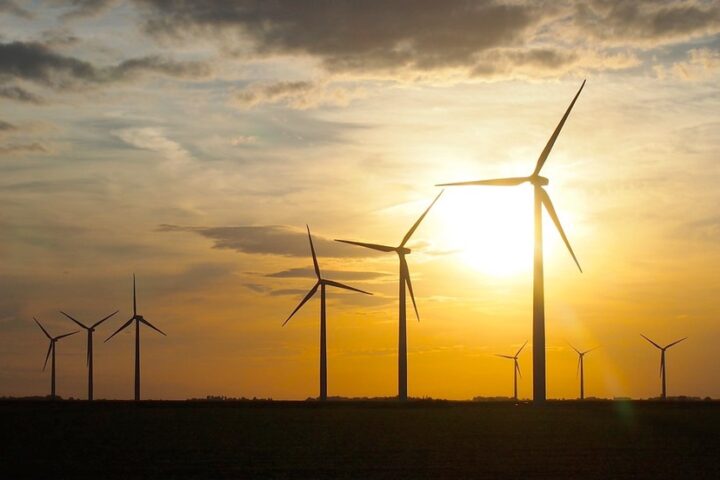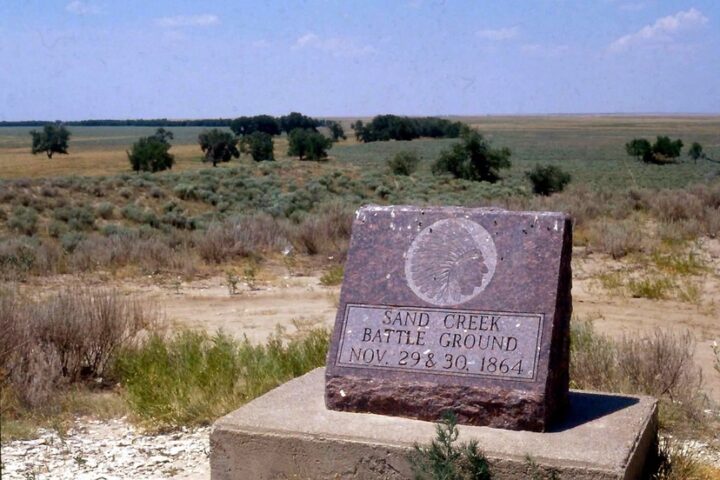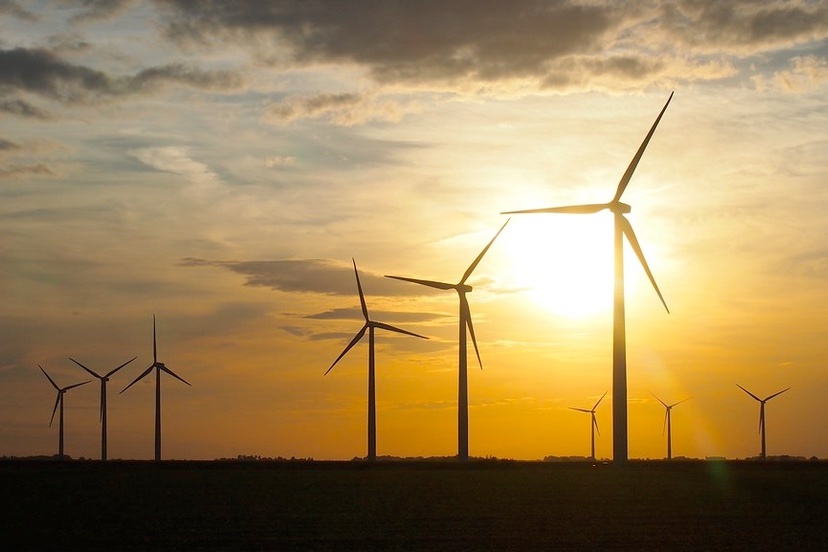Photo: Memorial marker at the site of the Sand Creek massacre, 1985. From Wikipedia.
This story by Allen Best appeared on BigPivots.com on April 29,2024.
Kiowa County lies in far eastern Colorado, cheek by jowl with Kansas. It’s a windy place, and dry, too.
No major rivers run through the county, and the few creeks — most notably Sand Creek, site of the infamous massacre of November 1864 – are ephemeral. The county gets 15 inches average annual precipitation. Less than 0.9% of the land is irrigated. Dryland wheat and sorghum dominate in that landscape of low rolling hills. It’s not the landscape that most associate with Colorado.
When Xcel Energy decided to build a $1.7 billion transmission power line sweeping across eastern Colorado to procure renewable energy, it was with the expectation that it would connect to wind and other renewable energy development would occur. Invenergy, the world’s largest developers of renewable energy, responded with plans for a pair of wind farms, Towner East and Towner West, which are to have 322 wind turbines spread across 160,000 acres. They’re named after a railroad siding with two grain elevators located two miles from the Kansas border.
Together, the wind farms will have capacity to generate 1,000 megawatts. The cost of each project has been tabbed at $1 billion.

For Kiowa County, whose largest incorporated town, Eads, has a population 657, this prospect of renewable energy investment has been well received. Writing in the Kiowa County Independent during February, State Senator Rod Pelton urged support. He stressed the financial stability that wind projects can bring to local landowners and county governments. To make his point, he cited the Rush Creek Wind Project, located about 50 miles to the north, in Cheyenne County, which he voted to approve as a county commissioner in 2017. The developer there was also Invenergy.
“Since then, we’ve seen the predicted benefits – jobs, local tax revenue, and stable income for farmers and ranchers – play out exactly as promised.”
The same company, Invenergy, at this new project — called Towner Energy Center — will result in more than $100 million in payments to local farmers, ranchers, and landowners.
“That’s three decades of predictable, stable income at a time when uncertain weather patterns and commodity prices have made financial planning feel more like fiction writing for eastern plains farmers and ranchers,” he wrote.
That, he added, would be in addition to nearly $100 million in local tax revenues.
But that tax revenue has become one of two issues that will likely slow and perhaps alter the project. Invenergy claims that Kiowa County unlawfully applied a 1% impact fee to each of the two projects. That will yield $20 million in fees for the county. In an April 26 story in the Kiowa County Independent, Betsy Barnett cites language in the lawsuit. The impact fees, it says, “are in no way tied to actual present and future direct impacts of renewable energy projects in Kiowa.”
The company also claims the money will be used to remedy Kiowa County’s deficiencies in existing capital infrastructure, service and facilities, not to the actual impacts of the wind projects. In this, argues Invenergy, Kiowa County has violated its own 1041 regulations as well as Colorado laws and the U.S. Constitution.
Without the impact fees, Invenergy estimates it will pay $1.53 million per year, nearly doubling the annual tax revenue for the county, not including the indirect economic impacts of increased spending and more jobs.
The second lawsuit, filed on April 11 against Kiowa County, comes from the Northern Cheyenne Tribe. The Montana-based tribe includes descendants of the massacre that claimed the lives of, by one estimate, 230 people, mostly Cheyenne but also some Arapahoe and several individuals of mixed Anglo and Native heritage.

The lawsuit contends the turbines and towers will be visible from the massacre site and the project area likely includes places where surviving tribal members later sheltered. The towers will be roughly equivalent to a 56-story building. The tribe contends that only 1% of the entire project area has been surveyed sufficiently to locate and record all historic properties. These and associated concerns were submitted to Kiowa County on February 12, prior to the County’s approval.
These issues were hashed out at a public hearing in February attended by 130 people.
As reported by the Independent, Jimmy Brown, a member of the county’s planning and zoning commission, urged the board to retain the 1% fee that Invenergy even then was trying to get lowered. Both Xcel Energy and Tri-State Generation and Transmission had paid the same 1% fee, he pointed out.
As for the whether the viewshed around the massacre site should be protected, a local landowner, Burl Scherler, pointed to buildings nearby that didn’t exist in 1864, and also that airplanes are allowed to fly overhead. Another local landowner reported that the closest wind tower is to be 9.5 miles away from the massacre site.
Xcel Energy had already altered the route of the transmission line in Kiowa County, part of the company’s 550-mile Colorado Power Pathway, to put more distance between the massacre site and the wires. The first transmission pole in this new segment between in Kiowa County was installed in March.
The site of the massacre became a national historic site in 2007 and was expanded in 2022.
About 750 Natives, mostly Cheyenne but also Arapahoe and a few others of mixed Anglo and Native descent, including George Bent, had assembled at the site after being assured of safety as long as they remained peaceful. That assurance was betrayed by a militia from Denver led by John Chivington. Well over half of the victims were women and children.
The name Chivington still exists on a signpost near the massacre site, but there are just a few homes and buildings.
Allen Best publishes the e-journal Big Pivots, which chronicles the energy transition in Colorado and beyond.

